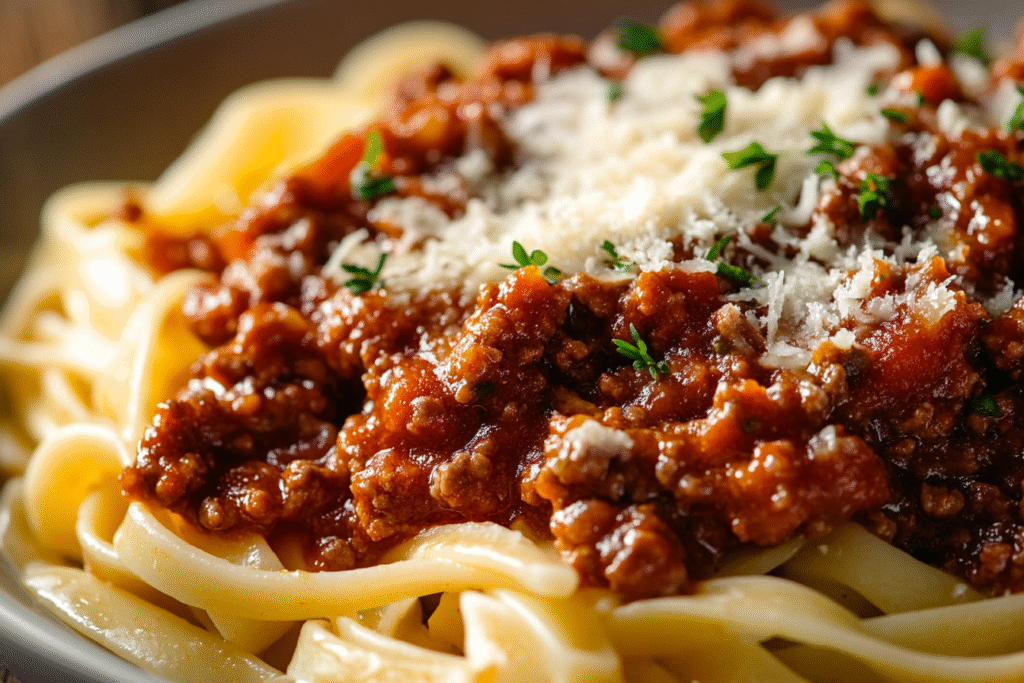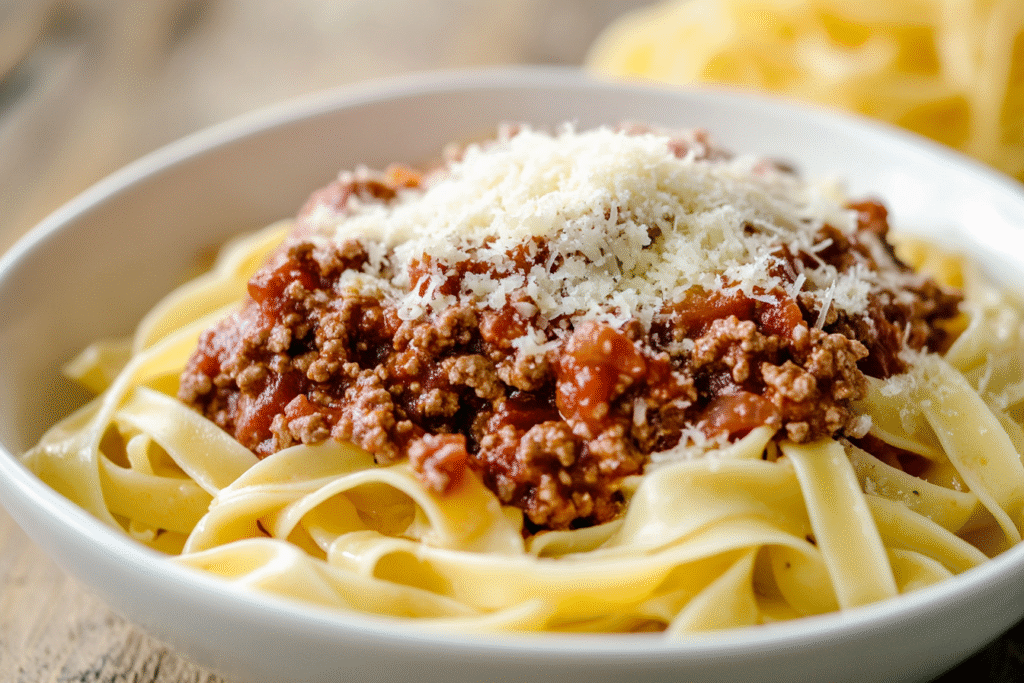Why Classic Bolognese Is the Gold Standard of Italian Meat Sauces
Classic Bolognese — or Ragù alla Bolognese — is not your average tomato meat sauce. Hailing from Bologna in northern Italy, this iconic dish is the heart and soul of traditional Italian cooking. It’s rich, savory, and layered with slow-cooked flavor. Unlike American-style spaghetti sauce, a true Bolognese is less about tomatoes and more about meat, soffritto, wine, and milk, all simmered for hours until everything melds into a velvety, deeply flavored ragu.
This isn’t a fast weeknight recipe — and that’s what makes it special. It’s a Sunday sauce, a slow project with delicious rewards. You build it with patience, respect the layering of ingredients, and let it transform over time. Whether served with tagliatelle, pappardelle, or even lasagna, a classic Bolognese sauce is pure comfort — humble in origin but luxurious in taste.
In this recipe, we’ll walk you through every detail: from selecting the right cuts of meat to the exact timing of wine and milk, and how to achieve that essential texture — not too saucy, not too dry. You’ll also find options for substitutions, storage, and variations.

The Origins and Essentials of Bolognese
Despite popular interpretations, real Bolognese doesn’t drown in tomatoes or herbs. In fact, in 1982, the Accademia Italiana della Cucina registered an official Bolognese recipe with the Bologna Chamber of Commerce. While every Italian family has its own version, the key elements remain consistent:
- Ground meat: Traditionally a mix of beef and pork.
- Soffritto: Finely chopped onion, carrot, and celery.
- Tomato: A small amount — usually just a spoonful of paste or a bit of purée.
- Milk: Balances acidity and adds creaminess.
- Wine: Deglazes and builds depth.
- Long, slow simmer: At least 2–3 hours, though longer is better.
It’s less a tomato sauce with meat and more a meat sauce with just enough tomato to unify it.
Choosing the Right Meat (It’s Everything)
The meat is the heart of this ragu. Here’s how to get it right:
- Beef chuck or brisket: Ground or minced, it offers great flavor and fat.
- Pork shoulder or pancetta: Adds sweetness and richness.
- Veal: Optional, but traditional in some regions for tenderness.
- Ground sausage (optional): For added complexity, though not typical in strict traditional versions.
Ideal ratio: 50% beef, 30% pork, 20% veal or pancetta.
Avoid lean meats. Fat is essential to achieve the sauce’s richness and prevent dryness.

The Soffritto: Italian Flavor Foundation
The aromatic base of onion, carrot, and celery (soffritto) sets the tone for your sauce. Finely dice — almost mince — the vegetables so they melt into the sauce as it cooks. This mixture shouldn’t brown; it should soften slowly in olive oil or butter to release its sweetness.
Add garlic if you like, though it’s not standard in traditional Bolognese. The goal is gentle background flavor, not sharp notes.
Tomatoes: Use Sparingly, But Purposefully
This is where most non-Italian interpretations go off track. A true Bolognese uses just enough tomato to bind everything together:
- Tomato paste: Adds depth and sweetness.
- Tomato passata or purée: Optional, and used sparingly — 1/2 to 3/4 cup max.
Skip canned diced tomatoes or crushed tomatoes. They add too much water and overpower the meat-forward balance.
Wine and Milk: The Signature Balancing Act
These two ingredients give Bolognese its signature complexity.
- Wine: Use dry white or red. White is more traditional and keeps the color lighter, but red adds richness. Either works as long as it’s dry and good enough to drink.
- Milk: Yes, milk! It’s added after the wine reduces to mellow acidity, tenderize meat, and give a silky finish.
Don’t skip either — they balance each other beautifully.
Recommended Equipment
While not fussy, Bolognese benefits from the right tools:
- Heavy-bottomed Dutch oven or large sauté pan: For even, consistent heat.
- Wooden spoon or silicone spatula: Gentle enough for stirring the meat without breaking it too much.
- Sharp knife or food processor: For finely chopping soffritto.
Optional but helpful: a splatter guard for the long simmer, and a ladle for occasionally adding water or stock.
Tips for the Perfect Texture
- Don’t rush: Each addition (soffritto, meat, wine, milk, tomato) should be cooked thoroughly before moving to the next.
- Simmer low and slow: The sauce should bubble gently, not boil.
- Add water or stock as needed: If it starts to dry out, don’t be afraid to add a splash to maintain a saucy consistency.
- Season gradually: Salt the meat and soffritto, then taste at the end before final adjustments.
The end result should be rich, thick, and deeply savory — not runny, but not dry.
Ingredients
For the Bolognese Sauce
- 2 tbsp olive oil or unsalted butter
- 1 medium yellow onion, finely diced
- 1 carrot, finely diced
- 1 celery stalk, finely diced
- 3 cloves garlic, minced (optional)
- 1 lb (450g) ground beef (80/20 or chuck)
- 1/2 lb (225g) ground pork (or pancetta, finely chopped)
- 1/2 cup (120ml) dry white wine (or red)
- 3 tbsp tomato paste
- 1/2 cup (120ml) whole milk
- Salt and black pepper, to taste
- Pinch of nutmeg (optional, but traditional)
- 1 cup (240ml) beef or chicken stock or water, as needed
To Serve
- Fresh tagliatelle, pappardelle, or fettuccine
- Freshly grated Parmigiano-Reggiano
- Chopped parsley (optional)
Instructions
1. Start the Soffritto
- Heat olive oil or butter in a large Dutch oven over medium-low heat.
- Add onion, carrot, and celery. Cook gently, stirring often, for 8–10 minutes until softened but not browned.
- Add garlic (if using) and cook for 1 more minute.
2. Brown the Meat
- Increase heat to medium. Add ground beef and pork (and pancetta if using).
- Break apart with a wooden spoon and cook until browned and most moisture has evaporated, about 10–12 minutes.
- Season with salt and pepper.
3. Deglaze with Wine
- Pour in the wine and stir, scraping up any browned bits.
- Simmer until mostly evaporated, 5–7 minutes.
4. Add Tomato Paste and Simmer
- Stir in the tomato paste and cook for 2–3 minutes to deepen flavor.
- Add 1/2 to 1 cup stock or water to loosen the sauce slightly.
5. Add Milk and Lower the Heat
- Pour in the milk and stir to incorporate. Add a pinch of nutmeg if using.
- Reduce heat to low. Cover partially and simmer for 2–3 hours, stirring occasionally.
- Add more water or stock as needed to maintain a rich but loose consistency.
6. Final Seasoning
- Taste and adjust seasoning. The sauce should be balanced — not overly acidic or salty.
- If desired, skim off excess fat from the top.
Serving Suggestions
Serve over freshly cooked tagliatelle — the wide ribbons are ideal for catching the sauce. Dust generously with Parmigiano-Reggiano and enjoy with a glass of red wine or dry Lambrusco.
Other pasta options:
- Pappardelle
- Fettuccine
- Rigatoni (less traditional but works well)
Avoid spaghetti — it’s not traditional and doesn’t carry the sauce as effectively.
FAQ & Troubleshooting
Can I use just ground beef?
Yes, but mixing with pork or pancetta adds depth and fat for a richer result.
Why add milk?
It tenderizes the meat and neutralizes acidity. It’s a hallmark of traditional Bolognese.
Can I make it ahead?
Absolutely. In fact, it tastes even better the next day. Store in fridge for up to 4 days, or freeze for 3 months.
Too thick or dry?
Add water or stock as needed. Stir frequently to prevent sticking.
Too greasy?
Skim off the top layer of fat after simmering, or let cool and remove solidified fat from the top.
Storage & Reheating
- Fridge: Store in an airtight container for up to 4 days.
- Freezer: Freeze in portions for up to 3 months.
- Reheat gently: In a saucepan over medium-low heat with a splash of water or stock.
Variations and Additions
- Mushroom Bolognese: Add finely chopped mushrooms to the soffritto for added umami.
- Vegetable version: Substitute lentils and mushrooms for the meat for a vegetarian twist.
- Spicy Bolognese: Add a pinch of chili flakes with the garlic.
Bolognese vs. Other Meat Sauces
- Bolognese: Minimal tomato, meat-forward, includes milk and soffritto.
- Ragù Napoletano: More tomato-heavy, often includes whole cuts of meat.
- American meat sauce: Tomato-based, often more saucy and seasoned with herbs like basil and oregano.
Classic Bolognese sauce is a masterclass in patience and simplicity — a dish that turns humble ingredients into something timeless, hearty, and soul-satisfying. Whether ladled over fresh pasta or layered into a lasagna, it’s a recipe that invites you to slow down, savor the process, and feed people well.


